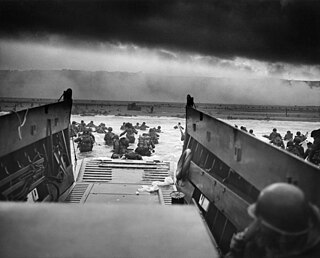Dday
| Normandy landings | |||||||||
|---|---|---|---|---|---|---|---|---|---|
| Part of Operation Overlord, Invasion of Normandy | |||||||||
 Men of the 16th Infantry Regiment, U.S. 1st Infantry Division wade ashore on Omaha Beach on the morning of 6 June 1944 |
|||||||||
|
|||||||||
| Belligerents | |||||||||
|
|
|||||||||
| Commanders and leaders | |||||||||
| Units involved | |||||||||
|
Omaha Beach: Utah Beach: Gold Beach Juno Beach Sword Beach
|
South of Caen Omaha Utah Beach Gold, Juno, and Sword |
||||||||
| Strength | |||||||||
| 156,000 | 50,350+ 170 coastal artillery guns. Includes guns from 100mm to 210mm, as well as 320mm rocket launchers. |
||||||||
| Casualties and losses | |||||||||
| 10,000+ casualties; 4,414 confirmed dead | 4,000–9,000 casualties | ||||||||
Omaha Beach:
Utah Beach:
Gold Beach
Juno Beach
Sword Beach
South of Caen
Omaha
Utah Beach
Gold, Juno, and Sword
The Normandy landings (codenamed Operation Neptune) were the landing operations on Tuesday, 6 June 1944 (termed D-Day) of the Allied invasion of Normandy in Operation Overlord during World War II. The largest seaborne invasion in history, the operation began the liberation of German-occupied northwestern Europe from Nazi control, and contributed to the Allied victory on the Western Front.
Planning for the operation began in 1943. In the months leading up to the invasion, the Allies conducted a substantial military deception, codenamed Operation Bodyguard, to mislead the Germans as to the date and location of the main Allied landings. The weather on D-Day was far from ideal, but postponing would have meant a delay of at least two weeks, as the invasion planners had requirements for the phase of the moon, the tides, and the time of day that meant only a few days in each month were deemed suitable. Adolf Hitler placed German Field Marshal Erwin Rommel in command of German forces and of developing fortifications along the Atlantic Wall in anticipation of an Allied invasion.
The amphibious landings were preceded by extensive aerial and naval bombardment and an airborne assault—the landing of 24,000 American, British, and Canadian airborne troops shortly after midnight. Allied infantry and armoured divisions began landing on the coast of France at 06:30. The target 50-mile (80 km) stretch of the Normandy coast was divided into five sectors: Utah, Omaha, Gold, Juno, and Sword. Strong winds blew the landing craft east of their intended positions, particularly at Utah and Omaha. The men landed under heavy fire from gun emplacements overlooking the beaches, and the shore was mined and covered with obstacles such as wooden stakes, metal tripods, and barbed wire, making the work of the beach-clearing teams difficult and dangerous. Casualties were heaviest at Omaha, with its high cliffs. At Gold, Juno, and Sword, several fortified towns were cleared in house-to-house fighting, and two major gun emplacements at Gold were disabled, using specialised tanks.
...
Wikipedia
